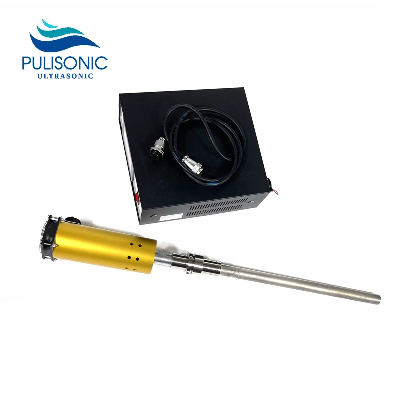Basic Info.Model NO.PLS-HLCSB1500After-sales ServiceOnline
SupportWarrantyOne YearTypeTubular ReactorMaterialTitanium
AlloyCapacity50-100LStructureSingle TubePressureUltrasonicAgitator
ModelCombined AgitatorTower Reactor TypeBubble Tower
ReactorHeatingElectric HeatingHeat Transfer
StructureCombinedAutomatic
GradeSemi-AutomaticConditionNewApplicationChemical ReactorProduct
NameUltrasonic Probe SonicatorKeywordUltrasonic Homogenizer
ProbeUsageMixing and Extraction DeviceItem NameUltrasonic Reactor
BiodieselFuntionHigh EfficiencyTrademarkPULISONICTransport
PackageWooden BoxSpecification1500WOriginFoshan, ChinaHS
Code8543709990Product Description Ultrasonic Probe Sonicator
Chemical Reactor is also called Ultrasonic Homogenizer Probe
vibrating rod. In terms of industrial application, the use of
ultrasonic vibrating rod for dispersion, extraction, cleaning,
chemical reaction, water treatment and so on is a very mature and
widely used technology.Performance characteristics,Suitable for
various high-power industrial liquid treatment, such as
homogenization, emulsification, dispersion, depolymerization and
wet grinding (particle size reduction), cell crushing and
disintegration, extraction, degassing and sonochemical
processes;Market application:*Traditional Chinese medicine
extraction: refers to the ultrasonic crushing (crushing) of
traditional Chinese medicine cells to achieve efficient extraction
of useful substances. Compared with the conventional extraction
technology, ultrasonic assisted extraction is fast, cheap,
efficient, safe, low cost and wide applicability.*Biodiesel
production: preparing bio oil diesel mixed emulsion by ultrasonic
emulsification is actually dispersing bio oil beads into another
immiscible diesel liquid. Compared with other technologies, the
droplets can be dispersed fine and narrow, high efficiency, good
dispersion effect, and can increase the stability of
emulsion.*Ultrasonic catalysis: the application of ultrasonic to
the catalytic reaction process can simulate the high temperature
and high pressure reaction in the reactor at the micro scale,
providing a very special physical and chemical environment for the
catalytic reaction that is difficult or impossible to achieve under
general conditions, so that the catalytic reaction can be carried
out in a mild environment. It can further improve the reaction
speed, shorten the reaction time and improve the yield of the
target product. The main applications are catalysis on metal
surface, phase transfer catalysis and enzyme catalysis.*Sewage
treatment: in the process of sewage treatment, the cavitation
effect of ultrasonic has a strong ability to degrade organic
matter, and the degradation speed is very fast, which makes it
possible to degrade harmful organic matter in water, so as to
realize the purpose of ultrasonic sewage treatment.*Ultrasonic
dispersion: refers to the process of dispersing and reuniting the
particles in the liquid through the "cavitation" effect of
ultrasonic in the liquid. Ultrasonic dispersion can be divided into
emulsion dispersion (liquid-liquid dispersion) and suspension
dispersion (solid-liquid dispersion), which has been applied in
many fields. The application of ultrasonic wave to the dispersion
of suspension also includes the dispersion of titanium oxide into
water or solvent in the coating industry, and the dispersion of
dyes into molten paraffin; The dispersion of drug particles in the
pharmaceutical industry and the dispersion of powder emulsion in
the food
industry.TypePLS-HLCSB1000PLS-HLCSB1500PLS-HLCSB2000Frequency20KHz20KHz20KHzPower1000W1500W2000W
Related products about 20kHz Titanium Alloy Ultrasonic Probe Sonicator and Generator for Ultrasound Biodiesel Reactor
-
 Waste Tyre Plastic Recycling Machinery Machine Tire Crusher Production Line Rubber Crumb Grinding Machine Equipment Tire Shredder
Waste Tyre Plastic Recycling Machinery Machine Tire Crusher Production Line Rubber Crumb Grinding Machine Equipment Tire Shredder
-
 Stretch Plastic Blowing Pet Bottle Making Blow Molding Machine Bottles Stretch Automatic Pet Bottle Blowing Machine
Stretch Plastic Blowing Pet Bottle Making Blow Molding Machine Bottles Stretch Automatic Pet Bottle Blowing Machine
-
 Waste Plastic Pet Bottle, Water Bottle Flake, PP/HDPE/LDPE PE Film Jumbo Woven Bags Plastic Crusher Machine, Plastic Crushing Washing Recycling Machine
Waste Plastic Pet Bottle, Water Bottle Flake, PP/HDPE/LDPE PE Film Jumbo Woven Bags Plastic Crusher Machine, Plastic Crushing Washing Recycling Machine
-
 Type 2 Wall-Mounted Electric Car Charging Station 7kw /11 Kwelectric Vehicle Charging Station Home Wallbox AC EV Charger Single Phase or 3three Phase
Type 2 Wall-Mounted Electric Car Charging Station 7kw /11 Kwelectric Vehicle Charging Station Home Wallbox AC EV Charger Single Phase or 3three Phase
-
 G-View G12W Wholesale Auto Car LED Headlight Bulb High Power H13 H11 9005 H7 H4 Car LED Headlights LED Car Lights
G-View G12W Wholesale Auto Car LED Headlight Bulb High Power H13 H11 9005 H7 H4 Car LED Headlights LED Car Lights
-
 New Design Porcelain Round Plates Dinner Set for Wedding and Banquet
New Design Porcelain Round Plates Dinner Set for Wedding and Banquet
-
 China 2023 New Design Super Soft 100% Polyester Microfiber Knitted Oversized Decoration Hoodie Blanket
China 2023 New Design Super Soft 100% Polyester Microfiber Knitted Oversized Decoration Hoodie Blanket
-
 Handmade Art Creative Materials Thickened White Paper Cup DIY Disposable Handmade Colored Paper Cup
Handmade Art Creative Materials Thickened White Paper Cup DIY Disposable Handmade Colored Paper Cup



